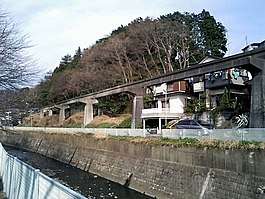Yokohama Dreamland Monorail
The Yokohama Dreamland Monorail (ドリームランドモノレール), formally the Dream Development Dreamland Line (ドリーム開発ドリームランド線, Dorĩmu Kaihatsu Dorĩmurando Sen) was a monorail connecting the Yokohama Dreamland amusement park to Ōfuna Station in Kamakura, Kanagawa, Japan. Operational for barely over a year between May 1966 and September 1967,[2][3] various attempts to restart or rebuild the line continued for 35 years, until it was finally decommissioned in 2002.[1][4]
| Yokohama Dreamland Monorail | |
|---|---|
 A section of track from the Dreamland Monorail in 2004 | |
| Overview | |
| Other name(s) | Dream Development Dreamland Line |
| Native name | ドリームランドモノレール |
| Type | monorail |
| Status | abandoned |
| Locale | Kamakura, Kanagawa |
| Termini | Yokohama Dreamland Ōfuna Station |
| Stations | 2 |
| Operation | |
| Opened | May 1966 |
| Closed | September 1967 |
| Operator(s) | Dream Transport |
| Technical | |
| Line length | 5.3 km (3.3 mi)[1] |
| Electrification | 1500 V |
History

Opened in August 1964, Yokohama Dreamland was Japan's first large-scale, modern amusement park and an instant hit. Due to its inconvenient location far from the nearest station, plans were soon drawn up to connect it to Ofuna Station by monorail, and a mere two years later, in May 1966, the Yokohama Dreamland Monorail was opened to the public,[5] offering an 8-minute ride from Ofuna station to the park. Despite a steep fare (at the time) of ¥170, the line was initially a hit, and with significant population growth in the area, plans were soon made to add an intermediate infill station[6] and extend the line to Mutsuai Station on the Odakyu Enoshima Line.[2]
However, cracks soon started appearing in the monorail beam.[1] The developers had been unable to buy the necessary land along the original route, forcing the route of the monorail to be changed, resulting in steep grades of as much as 100‰ (10%). The monorail vehicles were altered to cope with the high grades, increasing their weight, but the strength of the beam was not increased to match. It soon became clear that the beam was simply not strong enough to withstand these additional stresses safely, and in September 1967, the service was suspended[6] after operating for only one year and four months.[1]
Operator Dream Transport and constructor Toshiba promptly started debating who was responsible for the whole debacle, with mediation dragging on for 14 years until a settlement was finally reached in 1981. However, the settlement did not lead to repairs, much less restarting operations, and eventually the unmaintained infrastructure started to fall apart, with the vehicles decommissioned in 1987, the electrical transmission lines in 1991 and Ofuna's monorail station in 1992.[6]
Meanwhile, Yokohama Dreamland was purchased in 1988 by Japanese retail group Daiei, who decided to rebuild the line as a HSST maglev train. Planning started in earnest in 1995, with the line to be up and running by 1999. However, protests by local residents worried about electromagnetic radiation, as well as the high costs associated with the new technology, led to this plan being scuppered in 2001. Daiei proposed a conventional small monorail instead, but the continuing fallout of the bursting of the Japanese asset bubble and Daiei's subsequent economic difficulties meant that they did not have the capital necessary to build this.[5] Yokohama Dreamland was closed on February 17, 2002,[1] and on August 21 of the same year, with no financial support forthcoming from the City of Yokohama,[1] Daiei announced that they intended to abandon the line once and for all.[3][6]

Most of the remnants of the line were demolished by early 2005. Dreamland Station is now a parking lot, while the site of the Ofuna station has been turned into an apartment block. Some segments of the track itself still remain.[7]
Impact
Many of the lessons learned were applied to the Shonan Monorail, opened in 1970, which connects Ofuna to Shonan-Enoshima Station and is still operational.
References
- "ドリームランド モノレール線 ダイエー運行再開断念" [Dreamland Monorail Line Daiei Abandons Hope of Restarting Operations]. Yomiuri Shimbun (in Japanese). Tokyo. 22 August 2002.
- Demery, Leroy W. Monorails in Japan, p.25. Carquinez Associates, 2005.
- "モノレール大船・ドリームランド線」のモノレール事業中止に関するお知らせ" [Notice regarding the Cessation of Operations for the Monorail Ofuna-Dreamland Line]. Press release (in Japanese). Daiei. 2002-08-21. Archived from the original on 2007-09-27. Retrieved 2012-06-01.
- "ドリーム交通モノレール線: 年表" [Dream Transit Monorail Line: History] (in Japanese). Retrieved 2012-06-01.
- "Daiei unit gives up rights to Kanagawa monorail". Japan Times online. August 22, 2002. Retrieved 2012-06-22.
- "ドリーム交通モノレール線: 概要" [Dream Transit Monorail Line: Summary] (in Japanese). Retrieved 2012-06-01.
- "ドリーム交通モノレール線: 撤去" [Dream Transit Monorail Line: Withdrawal] (in Japanese). Retrieved 2012-06-01.
External links
| Wikimedia Commons has media related to Dream Kotsu. |